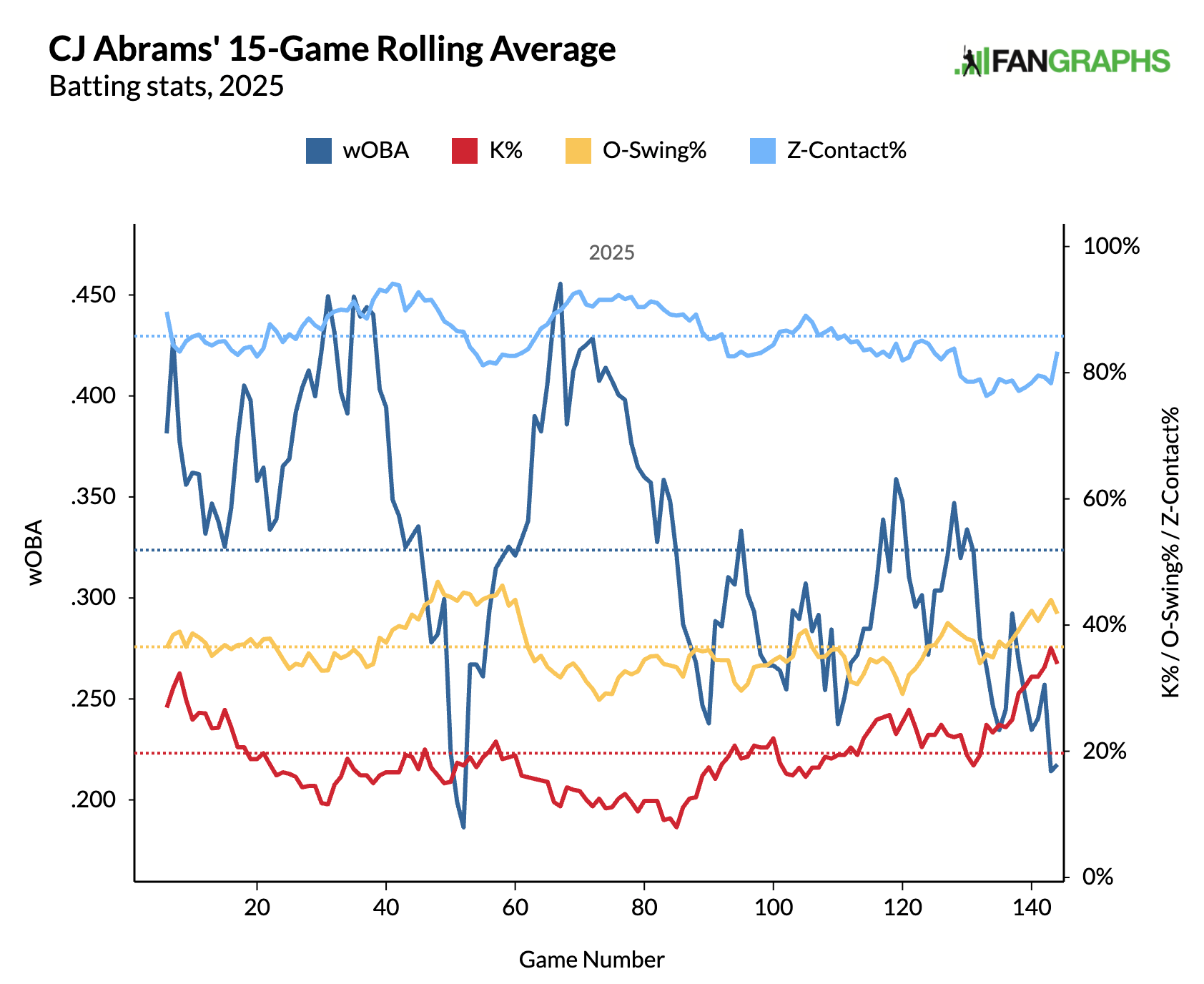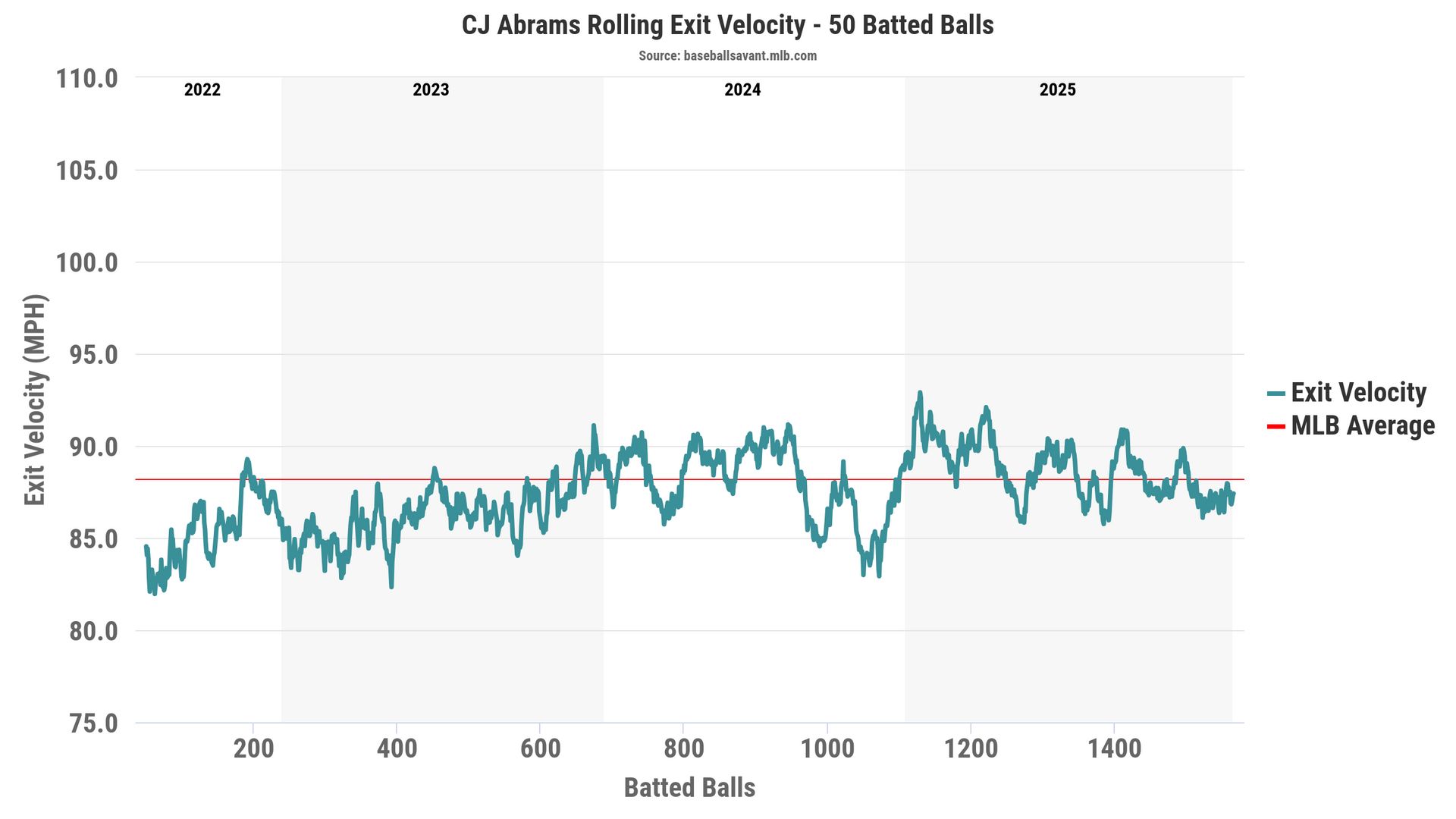- The Dynasty Dugout
- Posts
- Is It Legit? CJ Abrams Two Drastically Different Halves
Is It Legit? CJ Abrams Two Drastically Different Halves
CJ Abrams has been pretty consistent in performance the last three seasons, but a poor second half kept him from truly breaking out in 2025. What should we expect out of Abrams in 2026 and beyond?
Abrams’ 2025 season ended in a career-best 3.1 fWAR, but his surface hitting stats were nearly identical across the board as they were in 2024. This did not look like it would be the case early in the year as Abrams had 12 home runs, 20 stolen bases, and a .287/.351/.489 slash line entering the All-Star break. After that date, he hit just seven home runs; his slash was a bad .217/.266/.357.
Ending the year with 19 home runs and 31 stolen bases, Abrams has been the model of consistency. Last year, Abrams hit 20 home runs and stole 31 bases while having an OPS just one point off his 2025 mark, .747 to .748. This followed a first full season in which he hit 18 home runs and stole 47 bases.
Can you buy the first half performance? What caused the second-half slump? We will answer both and more below!
Check out our latest article on Pete Crow-Armstrong:
CJ Abrams Breakdown: Which Half Should We Trust?
The Numbers: CJ Abrams Edition
As we mentioned in the intro, Abrams has been pretty consistent throughout his career. Since 2023, his first full season with the Nationals, Abrams has averaged 19 home runs and 36 stolen bases per season and has a slash of .249/.310/.426. Abrams’ 2025 19.7 percent strikeout rate is right in line with his 19.6 percent career mark.
Abrams walked less often, a low 5.8 percent this year, which has consistently led to low OBPs. If you play in an OBP or points format, know that Abrams is going to play down a bit.
The good news is Abrams was extremely efficient on the base paths, stealing 31 bases on 34 attempts, and feels like a lock to steal at least 30 bases every season. The home run output was similar, and given the similar numbers year over year, why are we even writing about Abrams?
The Drastic Splits
We mentioned briefly in the introduction, but Abrams looked like he was on his way to a full breakout in the first half of 2025. Entering the All-Star break, Abrams had 12 home runs, 20 stolen bases, and a .287/.351/.489 slash. Over the final two and a half months, Abrams hit just seven home runs and slashed .217/.266/.357. What changed, and what can we learn?
The first thing I notice is a significant jump in strikeout rate. The first half saw Abrams strike out in just 16.3 percent of plate appearances, which jumped to 24.3 percent in the second. To no surprise, Abrams saw a drop in contact rate as his zone contact fell from 88 to 82.6 percent, and the overall number dropped five percentage points.

CJ Abrams 2025 Rolling Numbers
Something interesting to note is that Abrams saw fewer fastballs in the second half, while the number of breaking balls he saw increased by nearly five percentage points. The offspeed rate also jumped a few percentage points.
This is not surprising given that Abrams hit .293 this season against fastballs with a .474 slugging percentage and a whiff rate of just 17.4 percent. The batting average against breaking balls was .194, with an xBA just over .201 and a 36 percent whiff rate. These numbers are fairly reminiscent of what we have seen from Abrams in past seasons and make me wonder why he got such a heavy dose of fastballs early in the year.
Another interesting note is that while Abrams saw a drop in exit velocity in the second half, with his average falling from 89.3 mph to 87.8 mph, his barrel rate actually jumped from 6.9 percent to 8.6 percent. The launch angles did improve, despite a drop in line drives.
There are platoon splits as well as Abrams struck out at a ten percent higher rate against left-handed arms than against righties. While the batting average of .231 is not bad for left-on-left, his .619 OPS was a far cry from the .809 he posted against righties.
Second Half Injury
The other thing we need to highlight with these first and second half splits is an injury. While Abrams dealt with a thigh and hip injury in April, he was also scratched from the lineup in mid-July with shoulder soreness. He later sustained a jammed right shoulder and missed a game in September after diving into third base. You have to wonder if the shoulder bothered him the entire second half.
Checkin’ Under the Hood: CJ Abrams
From a statcast standpoint, Abrams put up a career-best 7.6 percent barrel rate in 2025, which was fueled by the second-half jump. The average exit velocity of 88.7 and his 104.1 mph 90th percentile exit velocities were also career best marks, but if you look at his Baseball Savant page, you will see nearly all his statcast data is below average.
From a bat tracking standpoint, Abrams did see an increase in bat speed for the third straight season, as his 72.4 mph mark was the only statcast metric to grade out above MLB average. One interesting thing is that Abrams has changed his position in the box slightly every year. After being around three degrees closed with his stance in 2024, Abrams was four degrees open in 2025. He was also over five inches wider in his stance.

CJ Abram Rolling Exit Velocity by Year
Abrams did post a new max exit velocity of 112.7 this year, but the majority of his metrics were in line with what we have previously seen. The .363 xwOBACON was a slight decrease from the previous season, as was his 39.2 mph hard-hit rate.
From a contact perspective, we mentioned things fell off in the second half, but his zone and overall contact rates were both slightly better than MLB average. The biggest issue comes from the number of swings on pitches out of the zone. Abrams' chase rate was 32.6 percent, the best mark of his career, as he had been over 35 percent in every other season. That is a positive trend, but the lack of walks is still concerning.
CJ Abrams 2025 Verdict and Future Outlook
I have to do a little speculating here, but I think it is possible that Abrams’ shoulder was not 100 percent for the second half of the season. We know that at two different points, it caused him to miss games, and it is possible he just played through over the final few months of the season. Given the increase in whiffs and the drop in exit velocity, it seems like a possible explanation.
One way to potentially back this is a drop in bat speed and a notable drop in ideal attack angle. If the shoulder was bothering him, naturally, the swing path might change ever so slightly, and that is what we saw. The attack angle changed by two degrees, but the ideal attack angle dropped by eight percentage points.
The other thing that leads me to believe the shoulder was not 100 percent healthy was the lack of stolen bases down the stretch. Being successful on 26 of his first 29 attempts means he would have continued getting the green light. But over the final two months, Abrams attempted just five stolen bases and was successful on all of them.
Regardless, Abrams’ 2025 season will be defined by two halves. The good news is that he still finished with his best season by WAR, and the surface numbers were right in line with what we have seen for his entire career.
CJ Abrams rockets one out on the first pitch 🚀
— MLB (@MLB)
6:15 PM • Jul 27, 2025
Looking toward 2026, Abrams will enter his age-25 season and is not even in the “prime of his career.” Abrams could be better in 2026, but even if not, you know what you are getting out of him. Given the consistency, you can expect around 20 home runs and at least 30 stolen bases. Even the fact that he only stole five bases over the final two months could mean we see more from a healthy Abrams next year.
If you are comfortable with 20 home runs and 30 stolen bases, low RBI totals, but potential at 100 runs in 2026, then Abrams is a good play. The batting average and OBP are not likely to be great, but given the contribution in three categories, Abrams will be solid. Value him accordingly.

Reply